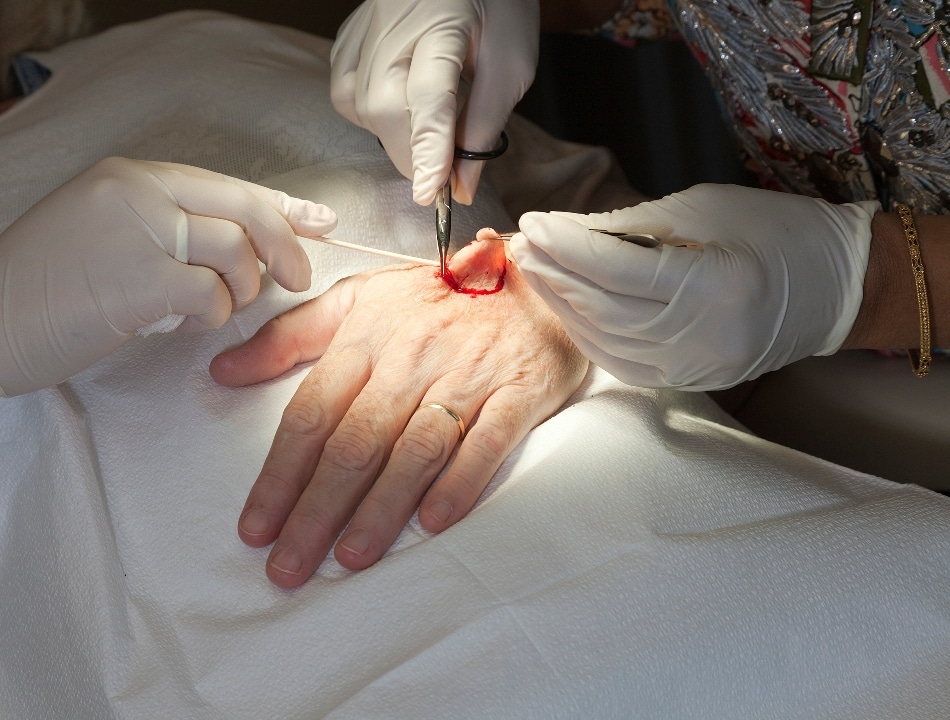Nov 12 2018
Scientists from Purdue University have created an innovative, translucent, and flexible base for silicon nanoneedle patches to transfer accurate doses of biomolecules directly into cells and increase observational opportunities.
 A surgeon performs surgery on the back of a hand of a patient who has melanoma. Purdue researchers are developing a new flexible and translucent base for silicon patches to deliver exact doses of biomolecules directly into cells and expand observational opportunities. The researchers say skin cancer could be one of the applications for the patches. (Image credit: Istock.com/lissart)
A surgeon performs surgery on the back of a hand of a patient who has melanoma. Purdue researchers are developing a new flexible and translucent base for silicon patches to deliver exact doses of biomolecules directly into cells and expand observational opportunities. The researchers say skin cancer could be one of the applications for the patches. (Image credit: Istock.com/lissart)
This means that eight or nine silicon nanoneedles can be injected into a single cell without significantly damaging a cell. So we can use these nanoneedles to deliver biomolecules into cells or even tissues with minimal invasiveness.
Chi Hwan Lee, Assistant Professor, Purdue University’s Weldon School of Biomedical Engineering and School of Mechanical Engineering
At present, silicon nanoneedles patches are placed between muscles, skin, or tissues where they transfer accurate doses of biomolecules. In general, commercially available silicon nanoneedles patches are developed on a rigid, opaque silicon wafer. Since the rigidity can lead to discomfort, it cannot be left in the body for a long time.
“These qualities are exactly opposite to the flexible, curved and soft surfaces of biological cells or tissues,” stated Lee.
Lee stated that the scientists had solved the difficulty.
To tackle this problem, we developed a method that enables physical transfer of vertically ordered silicon nanoneedles from their original silicon wafer to a bio-patch. This nanoneedle patch is not only flexible but also transparent, and therefore can also allow simultaneous real-time observation of the interaction between cells and nanoneedles.
Chi Hwan Lee, Assistant Professor, Purdue University’s Weldon School of Biomedical Engineering and School of Mechanical Engineering
A research related to the new procedure has been published in the Science Advances journal on November 9th, 2018. The collaborators from South Korea’s Hanyang University and Purdue’s Weldon School of Biomedical Engineering and School of Mechanical Engineering received joint support from the United States Air Force Office of Scientific Research and the Korean Ministry of Science and ICT to complete this study.
The nanoneedles are partially implanted in a thin, transparent, and flexible bio-patch that can be worn on the skin and can transfer regulated doses of biomolecules.
Lee stated that the scientists are hopeful about developing the functionality of the patch to act as an external skin patch, reducing the pain, toxicity, and invasiveness linked to long-term drug delivery.
According to Lee, in the next iterations of this technology, the scientists aim to investigate the operational validity of the potentials of the patch in treating cancerous tissues or monitoring cellular electrical activity.
This technology is in line with Purdue’s “Giant Leaps” commemorating the worldwide advancements of the university in health, artificial intelligence, space, and sustainability highlights as part of Purdue’s 150th anniversary. Those are the four themes of the yearlong celebration’s Ideas Festival, structured to exhibit Purdue as an intellectual center solving real-world issues.
A patent for the technology has been filed by the Purdue Office of Technology Commercialization.